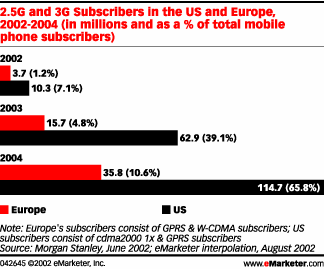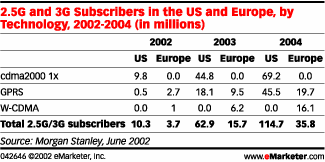 |
|
|
|
8 August 2002: By Ben Macklin Two roads diverged in a wireless wood, and Europe took the road less traveled by. The US, on the other hand, took the path of Japan and South Korea, and Ben Macklin tells Europe this with a sigh. Twelve months ago, it may have been a valid statement to suggest that North American wireless operators were lagging behind some of their Western European counterparts in terms of the roll-out of next generation networks and applications. This is not the case today. In fact, by the end of 2002, Morgan Stanley expects there to be nearly three times as many next generation wireless subscribers in the US than in all of Europe. By 2004, there will be 115 million next generation wireless subscribers in the US, compared to only 35.8 million in Europe. More importantly perhaps, over 65% of all US mobile phone subscribers in 2004 will have a mobile phone capable of data rates similar to a dial-up modem (40-60kbps). This compares to less than 11% in Europe at the same time.
The major difference between the two regions lies in mobile technology standards. All European operators are moving from their existing 2G GSM technology to the interim 2.5G of GPRS and then 3G with W-CDMA. Just 12 to 18 months ago, it was expected that that commercial GPRS services in Western Europe were imminent. In mid-2002, they still seem to be imminent. A combination of factors including a lack of GPRS handsets, initial high costs for data downloads, a lack of compelling data services and a global wireless sector still suffering have all been factors in the slow take-up of GPRS in Europe. In contrast, the alternative migration path to 3G, using cdma2000 1x, has seen rapid adoption, particularly in South Korea, Japan and now the US. The major US wireless operators who have launched or will shortly launch cdma2000 1x services are Verizon Wireless, Sprint PCS and ALLTEL, who between them have over 50 million mobile phone subscribers. With a variety of handsets already available, including color and camera-phone devices, adoption should be rapid.
The short-term benefit that cdma2000 1x operators will have over their GPRS counterparts is that the network upgrade provides them with an immediate increase in spectrum capacity. This is not the case with GPRS and will mean that increasing numbers of wireless data subscribers on GPRS will risk cannibalizing existing voice capacity. Cdma2000 1x is available right now in the US. While mobile phone users don’t give a brass razoo about technology per se, it does mean that over the later part of this year and in 2003, a wide variety of new handsets and wireless data applications will become available to millions of US mobile phone subscribers. At a time when there is little to cheer about in the telecom sector, this is worth cheering about. Ben Macklin is a Senior Analyst with eMarketer. You can reach him at bmacklin@emarketer.com with comments, questions or suggestions.
|
|||||


